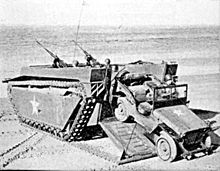LVT 4
| Landing Vehicle Tracked | |
|---|---|

LVT unloading Jeep
|
|
| Type | Amphibious vehicle |
| Place of origin | United States |
| Production history | |
| Manufacturer | FMC, Roebling, Graham-Paige, Borg-Warner, St. Louis Car Company |
| No. built | 18,620 of all variants |
| Specifications (LVT-4) | |
| Weight | 16.5 tons |
| Length | 26 ft 1 in (7.95 m) |
| Width | 10 ft 8 in (3.25 m) |
| Height | 8 ft 1 in (2.46 m) |
| Crew | 2–7 (up to 18 occupants total in transport variants) |
|
|
|
| Armor | 6–13 mm if added |
|
Main
armament |
2 × pintle-mounted 0.50 in (12.7 mm) Browning M2HB MGs |
|
Secondary
armament |
2 × pintle-mounted .30-06 Browning M1919A4 machine guns |
| Engine |
Continental W-670-9A; 7 cylinder, 4 stroke, air-cooled gasoline radial aircraft engine 250 hp |
| Power/weight | 15.2 hp/t |
| Payload capacity | 9,000 lb (4,100 kg) |
| Transmission | Spicer manual transmission, 5 forward and 1 reverse gears |
| Suspension | Rubber torsilastic |
| Fuel capacity | 140 US gal |
|
Operational
range |
150 mi (240 km) on road, 75 mi (121 km) in water |
| Speed | 20 mph (32 km/h) on land, 7.5 mph (12.1 km/h) in water |
| LVT(A)-4 | |
|---|---|

LVT(A)-4 amtank at Iwo Jima beach, ca. February/March 1945.
|
|
| Specifications | |
| Weight | 18.1 tonnes |
| Length | 7.95 m (26 ft 1 in) |
| Width | 3.25 m (10 ft 8 in) |
| Height | 3.1 m (10 ft 2 in) |
| Crew | 6 (commander, gunner, loader, driver, assistant driver, AA machine gunner) |
|
|
|
| Armor | 6 to 38 mm |
|
Main
armament |
1 × 75 mm M2/M3 Howitzer |
|
Secondary
armament |
3 × .30-06 Browning M1919A4 MGs |
| Engine | Continental W-670-9A; 7 cylinder, 4 cycle, radial gasoline 250 hp |
| Power/weight | 13.9 hp/t |
| Suspension | torsilastic |
|
Operational
range |
200 km (road), 120 km (water) |
| Speed | 40 km/h (25 mph), in water 11 km/h (6.8 mph) |
2 × pintle-mounted .30-06 Browning M1919A4 machine guns
The Landing Vehicle Tracked (LVT) is an amphibious warfare vehicle and amphibious landing craft, introduced by the United States Navy. The United States Marine Corps, United States Army, and Canadian and British armies used several LVT models during World War II.
Originally intended solely as cargo carriers for ship to shore operations, they evolved into assault troop and fire support vehicles. The types were known as amphtrack, "Amtrak", "amtrac", etc. (portmanteaus of "amphibious tractor"), and "alligator" or "gator".
The LVT had its origins in a civilian rescue vehicle called the Alligator. Developed by Donald Roebling in 1935, the Alligator was intended to operate in swampy areas, inaccessible to both traditional cars and boats. Two years later, Roebling built a redesigned vehicle with improved water speed. The United States Marine Corps, which had been developing amphibious warfare doctrine based on the ideas of Lt. Col Earl Hancock "Pete" Ellis and others, became interested in the machine after learning about it through an article in Life magazine and convinced Roebling to design a more seaworthy model for military use.
Both the US Navy and Roebling resisted the idea of a military design, the US Navy because it felt conventional landing craft could do the job, and Roebling because he wished his invention to be used only for peaceful purposes. Roebling was persuaded after war broke out in Europe, and completed a militarized prototype by May 1940. The Bureau of Ships requested a second prototype with a more powerful engine, and the USMC tested the design in November 1940. Impressed by the second prototype, the Bureau of Ships placed a contract for production of 100 units of a model using all-steel construction, for a more rugged and easily produced design, and the first LVT-1 was delivered in July 1941. Another 200 units were ordered even before the first production units were delivered. After more improvements to meet requirements of the Navy, made difficult by Roebling's lack of blueprints for the initial designs, the vehicle was adopted as "Landing Vehicle Tracked" or LVT.
...
Wikipedia
